Notes & Comments
Engines
![]()
Notes & Comments
|
|
|
November 2004 |
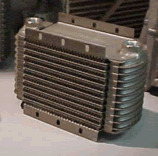
Niagara P/N 20002A oil cooler (formerly Harrison P/N 8526250)
The Falco engine installation and baffling was designed for the Harrison P/N 8526250 oil cooler. The Harrison Radiator Division of General Motors has discontinued their line of oil coolers. They sold the design to Niagara and the equivalent oil cooler is the Niagara P/N 20002A, which you can buy from Aircraft Spruce, Air Parts or Niagara Air Parts. Bill Kay is the product manager for the Niagara oil coolers at the NDM/Kintex Company, and can be reached at (419) 624-9188 or wkay@buckeye-express.com
The Stewart-Warner oil cooler will also work, with very minor changes, but the Falco baffling was, in fact, designed for the Harrison cooler.
|
October 2004 |
Dan Dorr took these photographs of the bottom of his engine, primarily to show the location of the sump fitting for the Christen Inverted Oil System.
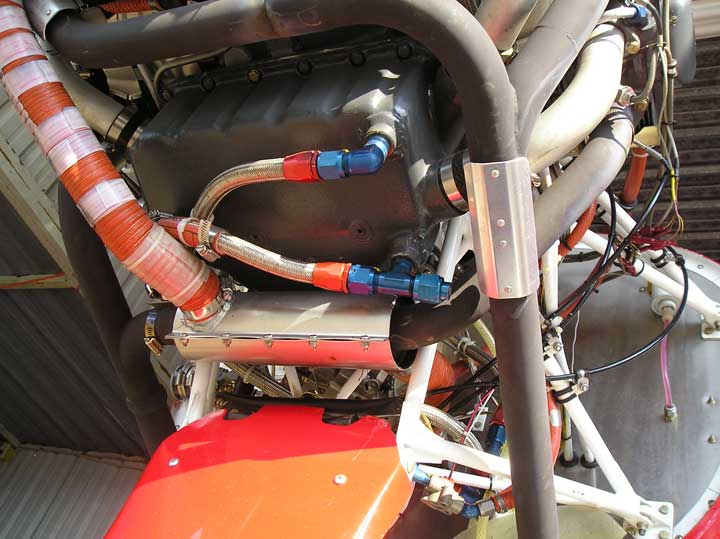
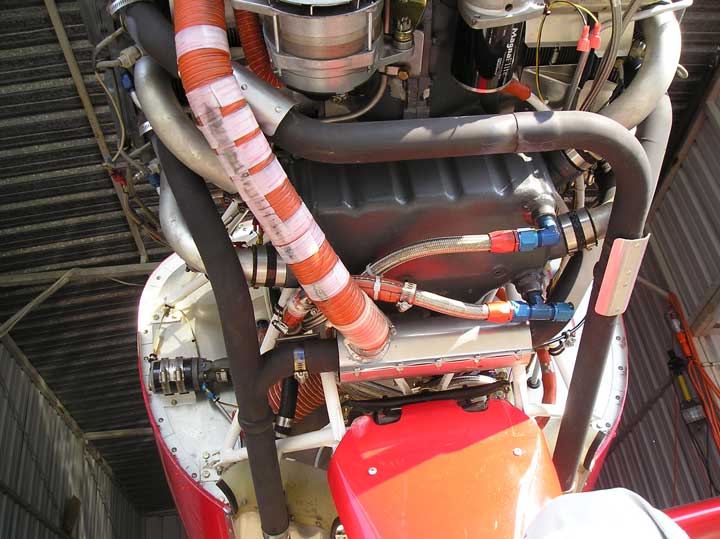
I finally got a few photos of the bottom of my engine when I removed the cowling recently. As I recall, I used the hole for the drain plug for one fitting (attaching a "T" fitting to retain the drain function). The other fitting required drilling a hole in the sump and welding in a threaded boss which was supplied with the inverted oil kit from Aviat (formerly Christen). I took my IO-360-B1E to an engine shop to have the the sump modified, and these photos show the installed results. Hope this helps.
Dan Dorr
|
From "Construction Notes" Falco Builders Letter, June 1996 |
Larry Black reports that he developed a problem with the fuel pressure line. There is a 1/8" aluminum tube that goes from the injector spider to a Swagelok fitting on the baffling. The tubing broke inside the Swagelok fitting, which has two ferrules which squeeze down on the tubing. The tube broke between the two ferrules, however the tube did not pull out, but a small amount of fuel leaked out in a tiny spray.
Larry is not sure why this happened. His Falco was one of those involved in the infamous mis-fueling fiasco on the West Coast of a couple years ago. As a result, he got a new engine, and Larry wonders if the problem was caused by the engine change. This is the first such incident like this, but it will give everyone something to watch out for.
|
From "Construction Notes" Falco Builders Letter, December 1997 |
Glyn Russell asks, "I'm installing the McCauley governor. The studs on the engine mount are too short. It looks like the governor has an extra plate on the attachment and that has two screws and for dowel pins to hold it on. It is approximately 1/2" thick. Is it possible that this is removed at installation so the bolts from the engine will work? If not, can you give me a recommendation?"
Lycoming engines are supplied with two types of studs for mounting the governor. The standard studs that come with the engine are too short, and you have to ask for long studs which will fit the McCauley governor. That plate is part of the governor and you leave it where it is. This is covered in our advanced builder memo which includes a complete specification for the engine.
|
From "Construction Notes" Falco Builders Letter, December 1997 |
The Weekly of Business Aviation reports that the NTSB has urged the FAA to require inspections of all Lycoming IO-320-B1A engines with the thinner propeller mounting flanges of a type that was superseded in production more than 20 years ago. The action stems from a 1986 fatal crash in which a Lancair 320 lost its propeller in flight. Investigation revealed that the broken propeller mounting flange had suffered fatigue cracking between lightening holes. The NTSB believes this cracking may have been initiated by gyroscopic bending loads on the crankshaft during aerobatics.
The NTSB is concerned that some of the engines used in Lancair 320 and other homebuilts may have the old-style thinnner propeller flanges, and that these aircraft using the IO-320-B1A engines "could be flown in a manner that could initiate cracking of the flange."
|
From "Construction Notes" Falco Builders Letter, March 1998 |
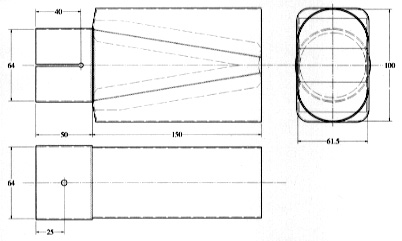
Jacob Brouwer sent us details of the silencer that he installed on his Falco. These are made by Hermann Liese Flugtechnik.
Hermann Liese has been making a few standard models of silencers that are used on a wide range of aircraft in Germany, where government regulations require a minimum noise level for the aircraft, or you can't fly the plane at all.
Hans Sonntag installed the Liese 76 x 150 mufflers. While they work and meet the government noise limits, they extend out underneath the aircraft, and they were difficult to install inside the cowling.
As a result of these problems and after consulting with Hermann Liese, Jacob Brouwer decided on the smaller 60 x 150 mufflers (Liese V60). These mufflers are mounted on the end of the exhaust tailpipes, and each of them will accept 140 hp with an exhaust back-pressure of 2" HG. A pair of these mufflers are routinely installed on 285 hp Beech Bonanzas.
We have included a drawing of the mufflers. These are made of stainless steel, and they fit over the exhaust tailpipe with a worm-type clamp that has an integral pin that fits in the 5mm hole and a matching hole that you drill in the tailpipe. While you may be tempted to try to fashion your own from these drawings, please be aware that these drawing do not show the internal loovers that are part of the design-and which we didn't draw because we don't know the details.
It's difficult to say how much power and speed these cost, but they do get the noise levels down to the strict German limits. They cost about $1,000 and if you're interested, please contact Hermann Liese Flugtechnik, Truderingerstr 2, D-82008 Unterhaching, Germany. Telephone: (089) 6113249, Fax: (089) 61501647.
|
From "Construction Notes" Falco Builders Letter, March 1998 |
Glyn Russell is in the process of finishing his Falco and was curious about the material that Steve Wilkinson used to wrap his exhaust system with. Steve replies, "The wrap is called Thermo-Tec, it's used on race cars and hot rods, and it's listed under 'exhaust wrap' in the Aircraft Spruce catalogue. Also, the naysayers who seem to gravitate to aviation will warn you that it causes exhaust cracks and other dire consequences. About a year ago, I was talking to the president of Borla Exhaust Systems, perhaps the preeminent manufacturer of aftermarket exhaust systems for Ferraris, Lamborghinis, Porsches and a wide variety of race cars, and I asked him about this. He said that was nonsense. If you wrap a cheap mild-steel tubing exhaust system with it, yeah, it'll crack, he said. But wrap any kind of quality stainless system, and you won't have to worry about it. Mine has been on for 400+ hours (I change it at every annual, since I inspect the pipes, and you can't re-use it) with no cracking."
|
From "Construction Notes" Falco Builders Letter, March 1998 |
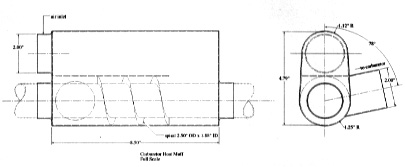
Charles Wagner has installed a Lycoming 0-320-E2A engine with a Bendix carburetor on the bottom of the engine with the air intake on the front and hot air for carburetor heat on the side. Charles found it difficult to come up with a heat exhanger which would fit in neatly, since there is little room in the engine compartment between the exhaust pipes and the cowling.
Charles came up with a carburetor heat muff which works quite well, on the ground at least. It is located at the front of the engine, under the alternator and starter motor, on the exhaust pipe from the starboard front cylinder. Charles says the minus point is that it is close to the landing light. The air intake hose to the muff also gets pretty close to the exhaust, but this is marginally improved by moving the air intake flange on the front starboard cowling a couple of inches outward.
We do not know if this design heats the air sufficiently to deal with carburetor ice. As I recall, the requirement for the temperature increase is something like 100°F. However, this design appears to be cleverly thought-out, and other builders who are working on this might be interested in seeing what Charles has done.
|
From "Construction Notes" Falco Builders Letter, March 1995 |
A couple of builders have asked recently for advice on overhauling an engine. In both cases, the overhauler wanted to install higher compression pistons in a 180 hp engine for additional power and proposed other power-boosting changes.
There are all sorts of things you can do to a Lycoming engine today to improve it. The most obvious thing is a lightweight starter. Terry Capehart has developed a nice aftermarket oil filter-Steve Wilkinson has one on his. Unison (formerly Slick) has a new electronic ignition system that's fully certified and which has two magnetos that continue to work if the electronic system craps out. Steve Wilkinson is going to get one of these and install it as well.
There are also lots of other things you can do to the inside of any engine. Some are sensible things and others aren't very wise. These generally fall into two categories: things that reduce vibration and things that increase power.
Reducing vibration is always a good thing to strive for. The simplest thing is simply selecting standard components off the shelf that match very closely in weight. This includes pistons, and connecting rods-and many people make a big deal about matching the weight of each end of the connecting rods. All that stuff is fine and dandy.
There are also other anal-retentive things like roller tappets and additional oil jets in the engine. I'm not qualified to comment on these things, but I don't think you're taking any real risk following the advice of a reputable overhauler on these sorts of things.
Where I have trouble, though, is with the power-boosting modifications to the engine. There is a direct relationship between engine power and reliability. Unless you're out to win races at any price and take all associated risks, I'd stay away from power-boosting modification. I'm most suspect of high-compression pistons, particularly when installed on second or third run-out engines. With each overhaul, the cylinder heads get a little closer to engine centerline, so if you add high-compression pistons, you're walking too close to the edge. The Lycoming marketing manager once told me he's seen lots of high-performance kitplanes with the cylinder heads completely blown off the engine because of this.
Opinions among experts vary on the subject of porting, polishing and flow-balancing. A little polishing and flow-balancing that smooths things out and reduces vibration is probably not a bad thing. More aggressive porting and polishing to boost power is one of those things that probably involves some trade-off in power for reliability.
Overall though, I'd always advise making your decision strictly for reliability. What I want in an engine is the most reliability I can get my hands on-a black box that will pump out power over the Alleghenies, Lake Michigan, the wastelands of eastern Wyoming or the Sawtooth Mountains of Idaho. If you've ever flown over territory like this, you come to appreciate that getting there is infinitely more important than arriving a few minutes earlier.
|
From "Construction Notes" Falco Builders Letter, June 1995 |
From Steve Wilkinson: "Another nice little addition I've made to the airplane is a 'custom duct' that fits between the air filter and the throttle-body inlet. Since that juncture has to be removed every time you take the cowl off to change the oil, after a while the stock SCAT (or whatever it is) tubing begins to unravel, and you have that awkward situation of trying to get the sproinging, Slinky-like wire onto the inlet and under the hose clamp, etc. It's a pain in the ass. But there's a guy out in Pendleton, Oregon, who makes 'custom ducts,' which are simply SCEET tubing (the high-quality, rubberlike orange ducting) onto which he vulcanizes permanent ends, once you've told him exactly what length and diameter you want. It's not cheap--a 10" length 3" in diameter cost me $35 (a little over $30 for the duct and the balance for shipping)--but it's very classy and solves a problem."
"His name is Tom Franke, the company is Custom Duct (they have a little ad in Sport Aviation), and his phone/fax is (503) 276-4588. He works as an A&P during the day, so you leave a message and he'll call you back in the evening or morning. Unfortunately, he doesn't take credit cards-check or COD only. For the specific application I outlined above, I would suggest a 9" length rather than the 10" I got. The heavy-duty SCEET tubing is not as flexible as SCAT, so it's a bit of a push to get the full 10" into place once you've got the lower cowling on."
|
From "Construction Notes" Falco Builders Letter, December 1995 |
Steve Wilkinson faxes, "FYI, I just got off the phone with a guy names Alex Borla, who is one of the top automotive exhaust-and-muffler experts in the country. He builds stainless-steel systems for everything from Lamborghinis and Ferraris on down, consults for Chrysler and Ford, and his systems are considered the performance-car after-market gold standard. He also does lots of race-car work."
"Anyway, I was interviewing him for an article I'm doing on the lightplane noise problem (he has a Baron and is working on designing muffling systems for aircraft), and when I was done, I asked him if what I was doing on the Falco-wrapping the exhaust system in that asbestos-like tape that supposedly keeps the exhaust hot and adds to the extractor effect, as well as slightly quieting it-was doing it any harm. He said that if the exhaust system was mild steel yes, but if it was a good-quality stainless, as our is, absolutely not. He also said that it indeed would add some power."
"He said that the only way you could possibly hurt the system by wrapping it with that tape is if you got the EGT about 1,700-which, of course, would require that you lean it to peak at a very high power setting. You probably already know all this, but he also said that the key to designing a durable high-performance header system is allowing the thing to 'work' through slipjoints, as everything expands at different rates. I described our system to him, and he said it sounded excellent."
"Anyway, I found that reassuring, since several people have looked at the asbestos wrapping and predicted a variety of apparently ill-informed doomsday scenarios."
|
From "Construction Notes" Falco Builders Letter, September 1994 |
Steve Wilkinson writes, "While reinstalling the engine in the Falco yesterday and today, I noticed some more-than-minor damage to the engine-mount structure, caused by vibration of the exhaust system. The damage was caused by the circular flange that forms the right end of the cabin-heat muff, and it consists of a shallow-C-shaped indentation in the engine mount at the point where the flange is in closest proximity to the mount, on the vertical tubing that comprises part of the nosewheel support structure.
"Apparently, there's literally no clearance at all at that point when the engine is running and the flange has worn its way into the steel tubing over an expanse of about an inch and a half in length, and I'd guess the indentation is about 1/16" deep at its worst point. There's no question which is the harder steel-the mount tubing or the heater-flange stainless-because there's absolutely no damage to the heater flange.
"I wouldn't be surprised if an IA who saw it on a production airplane wouldn't ground the thing, but right now, I've got enough work to do on the damn airplane that it's the least of my worries. I brought the exhaust system home with me yesterday and filed about a quarter-inch off the aft part of that right-hand header muff flange, and there now seems to be adequate clearance. But because several builders have called me over the last couple of years and said, "How did you get the exhaust system to fit? I can't seem to get enough clearance for the heater muff..." I wouldn't be surprised if this situation exists elsewhere. Nor would I be surprised if, in another 100 or 200 hours of flight, the vibration wouldn't wear its way clean through the tubing wall. It's something I think everybody ought to check next time they take the cowling off to change the oil."
Another thing to check are the metal tags that come on the oil cooler hose assemblies. Irving Jones, who recently bought Tim Baker's Falco, reported that both of the tags were loose and had vibrated so much that they had cut completely through the woven steel braid of the hose assemblies.
|
From "Construction Notes" Falco Builders Letter, September 1994 |
Jerry Walker reports that he bought a Slick harness for the Bendix magnetos, and with this harness, you don't need blisters on the cowling. Jerry has an IO-320-B1A engine, and is in the process of finishing the plane.
|
From "Construction Notes" Falco Builders Letter, December 1994 |
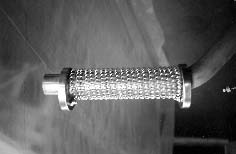
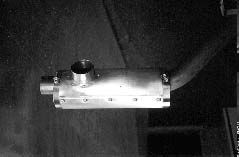

Howard Benham reports that in making the heat muff for his Falco, he found that two No. 5 door springs, stretched to 72" long, are a perfect fit. These are wrapped around the tubing and attached to the flange at each end. Springs are commonly used in heat muffs to transfer more heat from the tubing to the air. Howard and Marty are nearing the completion of their Falco and hope to start taxi tests in February or March.
|
From "Construction Notes" Falco Builders Letter, March 1993 |
The other day a salesman for Carborundum paid a visit. Ordinarily I don't welcome such visits, but this guy sells high temperature insulation fibers, and I decided to pick his brain. It didn't take long to establish that we're already using his products, since Fiberfrax is one of their products.
"What is this stuff?", I asked, and he explained that it's an alumina/silica fiber. It's one of the best insulators in the world, and it was developed almost by luck around the turn of the century by a guy in one of their labs. Curious to see what would happen, he combined alumina and silica, heated both to the melting point, and then opened a valve on the steam heating system and dribbled the stuff down in the steam.
It made fibers, and that's essentially the same thing they do today, but obviously under tightly controlled conditions. The fibers are processed and woven into a wide variety of products, from felt-like papers in the case of Fiberfrax, to woven cloths, tubes, blankets, and even molded with a binder into tiles for the space shuttle.
I showed him how we are using Fiberfrax for the firewall and in the exhaust ports of the Falco, and he said it was an ideal way to use the material.
I also asked him about the practice of using insulating materials on the exhaust pipes. He said he was familiar with the practice with race cars, and said there were several factors to be aware of. On cars, and presumably on aircraft engines as well, insulating the exhaust pipe raises the cylinder temperatures. On an aircraft engine with an installation like the Falco, it has other benefits as well. By keeping the exhaust gasses hot, the exhaust remains at a high speed, and you get better thrust from it.
Also, by insulating the pipes, you prevent the heat from the exhaust pipes from heating and expanding the lower-deck cooling air from the engine. Expanding this lower-deck air increases the cooling drag. While the effects are probably slight, this practice is one that is being slowly adopted by homebuilders in pursuit of speed.
Steve Wilkinson has used some Thermo-Tec Wrap sold by Aircraft Spruce. This is a woven fiberglass material that's not greatly different in makeup from the fiberglass cloth that's used for laminating with epoxy. While it's a decent insulating material, the woven fiberglass cloth will crystalize when exposed to heat, so you can use it only once. The man from Carborundum also cautioned against using this type of material for a second reason-an oil leak that dribbles oil on a porous material like this can result in a fire that's hard to get out. He cautioned against using any porous, absorbant materials for this reason.
A better approach, he said, was to use the method Karl Hansen used. Wrap the exhaust pipes with Fiberfrax (which is a better insulator than fiberglass anyway) and then cover it with a heavy aluminum foil tape. It gives you better insulation but without the problems associated with porous, absorbent materials.
The use of an insulating wrap on exhaust pipes is a practice that's still in the semi-experimental stage. There have been some worries that, because of the higher temperatures of the exhaust system, there might be a problem with cracks appearing in the pipes. So far, I haven't heard of any problems 'in the field', but it still pays to pull the stuff off every year and inspect the exhaust system.
|
From "Construction Notes" Falco Builders Letter, September 1993 |
Gary Montgomery also asked about the smoke system, if a system might be set up by putting a small tank in the luggage compartment, and whether this would include the pump and/or needle valve as required for a complete smoke system. He doesn't know how much oil is fed to the exhaust per minute and how it is pumped there. It's been years since I first looked at the smoke system, and I remember very little of this except that I did provide the smoke system with a 3/8" line, same as the fuel system. I also remember that you typically use a 7 psi fuel pump mounted with the tank on the right seat. That's the limit of my knowledge, but if you are going to install such a system, you might want to quiz some air show pilots about how and what they do.
|
From "Construction Notes" Falco Builders Letter, September 1991 |
At McCall, I was interested to see John Harns's installation of the engine breather tube. Like many other builders, he's run the breather hose into the exhaust by welding a 3/4" stainless steel tube into one of the exhaust system tailpipes. This way, any oil that pukes out during aerobatics goes out with the exhaust. It has put an end to oil on the belly of the plane.
The thing that interested me was the length of the tube. Others have told me they used a three-inch-long tube, but when Steve Wilkinson tried that, it burned the hose. John Harns had a tube that was about 7 to 8 inches long and hasn't had any problem with the hose overheating.
|
From "Construction Notes" Falco Builders Letter, December 1991 |
George Barrett asked the other day about installing engine pre-heaters. As it turned out, Steve Wilkinson had mentioned the same thing several days before, and I suggested he contact Charles Gutzman who has one on his Falco to find out if there's anything special to know about these things. Thinking I might write something about this, I mentioned it to Steve Wilkinson, who sent me the following notes:
I don't know much beyond what I've read and seen second-hand, such as the contortions of a friend of mine who carries a Red Dragon propane heater in a metal box in his Skylane wherever he goes, summer and winter. The most impressive thing I've ever seen it do was knock out the Skylane's rear window-the top one-when his 18-year-old son took the 'lane up and tried to demonstrate zero gravity to a girlfriend with the heater chest sitting in the baggage compartment.
I just ordered a Safe-Heet external oilpan heater probably about identical to the E-Z Heat unit on Charles Gutzman's airplane. (The reason I didn't take Charles's advice is that the E-Z Heat unit requires you to somewhere procure Permatex P-77 gasket goo/adhesive whereas the Safe-Heet unit comes as a complete kit.) The E-Z Heats are sold by Chief Aircraft and can also be bought-same price, about $140-from Chief via the Wicks catalogue. The Safe-Heet comes from an 800-number ad in Trade-a-Plane and as I remember was $147 including the adhesive. I think it's also 4x5 inches versus the E-Z Heat's 4x4 (for four-cylinder Lycomings, at least).
The classic engine heater is the Herman Nelson-that big unit that looks like a GPU, which big FBOs wheel out and use to blast the paint off the cowl of your Cherokee. When I was flying up in the Canadian Arctic with Weldy Phipps, we always used Herman Nelsons to get the Beavers and Otters warm in 40° weather.
The basic dispute between heater manufacturers, as I understand it, is that the makers of the hot-air heaters-from Herman Nelson down to Tanis and Red Dragon-say, "Heating only the oil does absolutely no good. The minute it hits the cold oil passages and cylinders, it's as cold as when you started the process." The tech rep I talked to at the company that makes the Safe-Heet said that's bull-that oil is an extremely good heat sink; that it takes a long time to get it hot and that it holds its heat for the same reason and conducts it to cold metal quite effectively.
I'm sure that heating the entire engine with hot air-oil, case, cylinders and accessories, plus you can then blast the thing into the cockpit and heat the instruments-is the single most effective way to go, but I don't think there's much argument in terms of convenience. Either you go through the somewhat complex, active process of setting up your hot-air heater and then stand around for an hour monitoring it while flames glow here and there and you stuff spare rags into cowl openings... or your plug your safe, external oilpan heater into a self-timer, go home, then the heater comes on automatically, passively the next morning at 0300 and the oil's at full operating temperature by the time you arrive at the airport at 9. Of course, the latter requires a hangar (or some other electrical outlet) whereas the propane heater can supposedly be used anywhere... if the igniter works, which it often doesn't, and if you can then light a match in the howling wind on the ramp.
There are also dipstick heaters-at least there are for cars-but if you're going to heat the oil electrically, why not heat the oil pan, too?
The oilpan heaters have integral thermostats, so they go off and recycle whenever the temperature of the pan (and assumedly of the oil) reaches 165 degrees. So they can be hooked to timers and safely left alone. The one thing you don't want to do, however-the Safe-Heet people tell me-is plug it in for several days at a time. If you do that, it begins to cook the moisture out of the oil, and that moisture will rise and precipitate out as soon as it hits cold upper-engine parts such as the camshaft, creating instant rust.
Steve Wilkinson
|
From "Construction Notes" Falco Builders Letter, September 1990 |
Steve Wilkinson has discovered that the governor control cable bracket, when mounted to the new McCauley governor, comes dangerously close to the left magneto P-lead terminal, and that if it touches the terminal, it would ground out the magneto and thus 'turn off' the magneto. I don't remember ever seeing this problem with the Woodward governor and can only warn you to look for the problem and fix it however you can until I can come up with an 'official' fix for you. Steve is talking about notching the bracket, reinforcing it and riveting on some type of insulating material (like phenolic, or a wood block) which will bump against the magneto and keep it from hitting the terminal.
I meant to look at the magneto/bracket relationship on Jim Slaton's Falco but forgot. I think it would be a good idea for everyone to take a look and see if this potential problem exists on your airplane.
|
From "Construction Notes" Falco Builders Letter, March 1988 |
Terry Smith is installing a 180 hp IO-360-B1E. Apparently on this engine, the fuel pump to injector hose assembly is a -6 size, and Terry already had a 7" Aeroquip 303 hose assembly made up in the -4 size. If you need one, please contact Terry at 415 River Street, Forty Fort, PA 18704. Telephone: (717) 288-6288 home or 287-4912 office. The hose is fine for an IO-320-B1A, and it cost Terry $35.00.
|
From "Construction Notes" Falco Builders Letter, June 1988 |
I stopped by to see Joel Shankle the other day and noticed a couple of very minor things that he had not seen. ...
The other thing is that the oil cooler lines should be threaded through the induction tubes-this puts them well clear of the exhaust pipes-and the outboard fitting into the oil cooler should be tilted inboard for greater clearance with the cowling.
|
From "Tool Talk" Falco Builders Letter, June 1988 |
Fly behind an injected Lycoming and sooner or later you are going to encounter dirty injector nozzles. Even if grit doesn't get you, gum will. Karl Hansen has a neat little tool to clean the nozzles. It's nothing more than a short length of solid copper hookup wire with about 1-1/2" stripped of the insulation. When the engine runs slightly rough, Karl just chunks this thing down into the nozzles to clean them, and the engine runs smooth again. Because it is copper, it's too soft to hurt the nozzles-for that reason, you don't want to use brass or stainless steel wire. Karl thinks it is 20 or 22 gauge wire which he got at Radio Shack.
|
From "Construction Notes" Falco Builders Letter, December 1987 |
If you are going to install a Christen inverted oil system in your Falco, take note-this little problem cost Pawel Kwiecinski a week. The Christen system connects a line to the horizontal screen on the right aft end of the oil sump. You have a choice of two fittings, and you must use a Christen P/N 804-A Angle Fitting. The straight fitting will not work due to an interference problem with the engine mount. The Angle Fitting, fortunately, is a swivel fitting.
|
From "Construction Notes" Falco Builders Letter, September 2001 |
At Oshkosh, Dave Nason reported that he had made a minor adjustment to the engine baffling that he recommends for anyone. He has a digital four-cylinder CHT, and found that his right front cylinder was running about 25 degrees hotter than the left front cylinder. On the right front engine baffling, at the cylinder head, the baffling has a turned-up flange in front of the cylinder head. He reduced this to a height of about 5/16" and the temperatures of his two front cylinders both came down and ended up at the same temperatures. This is the turned-up flange for the cylinder head, not the cylinder barrell.
|
From "Construction Notes" Falco Builders Letter, December 2001 |
Cecil Rives is always looking for ways to make his Falco faster, since fast women are out of the question, and he investigated the idea a plenum cooling system. The plenum is a box that fits over the top of the engine and keeps air from leaking out through the baffling, starting ring and upper cowling. It's a type of system used on the Swearingen SX-300, and it makes the top of the engine inaccessible, but if you're an anything-for-speed type, then you don't care about that.
It's hard to say if a system like this is worth the effort
and cost. After investigating it, Cecil decided against it, in
part because it would require the relocation of the oil cooler.
If you are interested in looking into this, contact Sam James,
12185 Schooner Lane, S.W., Moore Haven, FL 33471. Telephone: (863)
675-4493
|
From "Construction Notes" Falco Builders Letter, March/June 2002 |
Dave Nason has installed a ceramic coating on his exhaust system. The coating is sprayed and baked on both the inside and outside of the exhaust system pipes, and it insulates the system so that the engine compartment is cooler and the exhaust air is hotter. Dave says the exhaust gasses are burning cleaner and that he gained about 2 mph at the top speed -- now 233 mph at full throttle and low altitude. The process costs about $110-120 and was installed by Performance Coating.
|
From "Construction Notes" Falco Builders Letter, September 2002 |
The other day I talked with the folks at Sky-Tec. They confirmed what I already knew-that they don't make a starter that will fit our I0-360-B1E because of solenoid interference problems. And the I0-360-B1E we order from Lycoming comes with a Sky-Tec starter (I assume that the I0-320 has the same problem, but I don't know for sure).
I learned that a Magnaflite starter with an inline solenoid will fit, and I was about to order one. But, in my conversation with Sky-Tec, they told me that in about 90 days they will have a new starter available with an inline solenoid that should fit.
They told me they would take a straight exchange for the starter I already have, which will save me a few hundred bucks. It will take them a little longer to get the new starter certified and on the market, but since I'm a homebuilder, they said I should be able to get one directly from Sky-Tec in about 90 days.
Dan Dorr
|
From "Construction Notes" Falco Builders Letter, March 2003 |
On the electric fuel boost pump there is an inlet, and outlet and a vent of some sort. What is that for exactly?
George Richards
I have always assumed that the vent was there in case the pump broke a seal and started to leak. We plumb it to an overboard vent line.
|
|